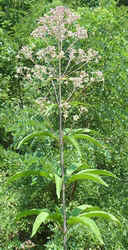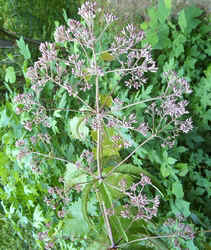 |
 |
 |
Common Name: Joe-Pye-Weed, Sweet Joe-Pye-Weed, Queen-of-the-Meadow
Scientific Name: Eupatorium fistulosum
Family: Asteraceae
Serendipity Ranch
Columbus, North Carolina
August 5, 2002
 |
 |
 |
These hollow-stemmed perennials, 3 - 7 feet tall, have whorled leaves and a large, rounded inflorescence up to a foot or more broad, made up of many small flower heads. Indigenous to the eastern U.S., this Eupatorium grows in bogs, marshes, and meadows chiefly of our mountains and piedmont. July - October [Justice, William S. and Bell, C. Ritchie, Wild Flowers of North Carolina. University of North Carolina Press, Chapel Hill, 1968]
Use all your senses to appreciate this robust wildflower. The plant is tall and the leaves are in whorls of 3 - 4. The stem is greenish, then dark purple at the nodes where the leaf whorls are. Gently scrape the stem with your fingernail and smell the vanilla odor. Rub a leaf and note that it is toothed and slightly hairy. The cluster of flower heads is rounded, highly branched, and 3 - 12 inches across. Sweet Joe-Pye-weed is a popular garden plant, not only because of its wonderful size and showy flower cluster, but also because it attracts beautiful pollinators. Tiger swallowtail, monarch, red admiral, and painted lady butterflies will nectar simultaneously on a single flower cluster. July - September [White, Peter, Wildflowers of the Smokies. Great Smoky Mountains Natural History Association, Gatlinburg, 1996]
"Weed" is the wrong name to apply to such a stately plant. Huge clusters of pink-purple flowers, atop coarse stems up to 12 or 15 feet high, are especially attractive, in both form and color, when seen against a blue sky. The flowering season is July through September. [Campbell, Carlos C., Hutson, William F., Sharp, Aaron J., Great Smoky Mountains Wildflowers, Fourth Edition. The University of Tennessee Press, Knoxville, 1977]
Joe Pye is said to have been an herb doctor who lived in New England in colonial times, when the colonists made a tonic of these roots to treat diarrhea. The plant named for him is hardly a "weed" in the ordinary sense as it is one of our most stately and handsome herbs. A more fitting name, "queen-of-the-meadow," is applied to it in the southern mountains. Some of these plants reach a height of 12 feet or more in low moist ground. The large, coarsely toothed leaves are arranged in whorls along the stem, with 3 to 6 leaves per whorl. The numerous flower clusters are grouped into a huge, frosty-pink, rounded or pyramidal head. [Stupka, Arthur, Wildflowers in Color. HarperPerennial, A Division of HarperCollins Publishers, New York, 1965]
The genus name Eupatorium honors Mithridates Eupator, king of Parthia, 120 - 63 B.C. He was the first person reported to use a species of Eupatorium for medicinal purposes. Fistula is Latin for a pipe or tube, referring to the hollow stem. The common name, Joe Pye, comes from two sources. Joe Pye was a medicine man (Native American or Caucasian), who used the root of one of the tall, pink, flowering Eupatorium spp. to bring about sweating to treat the fever of typhoid. In addition, the Indian word for typhoid, jopi, sounds phonetically like the name, Joe Pye. Historical medicinal uses of Joe Pye weed are numerous. Teas made from the whole herb and the root relived urinary tract problems. One common name for it is "little water medicine." Another name, gravel root, refers to the use of Joe Pye weed to treat kidney stones. Native American women drank an infusion of the root as a tonic during pregnancy. Various species were used to treat colds, aches, love problems and crying children. [Midgley, Jan. W., Southeastern Wildflowers. Cranehill Publishers, Hong Kong, 1999]
January February March April May June July August September October November December
Alphabetical Listings -- A B C D, E F G H I, J, K L M N, O P Q, R S T U, V W X, Y, Z
Family Listings -- A B C D, E F G H I, J, K L M N, O P Q, R S T U, V W X, Y, Z
Genus Listings -- A B C D, E F G H I, J, K L M N, O P Q, R S T U, V W X, Y, Z